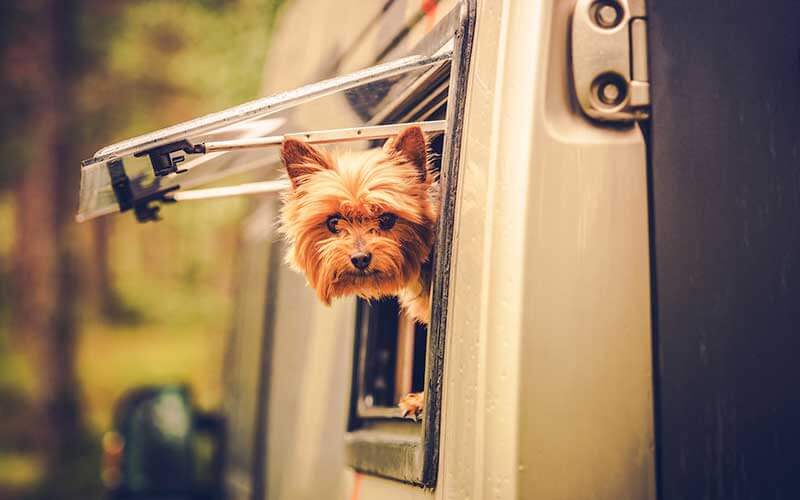Traveling to Florida with your pet can be a very rewarding experience, especially if you’re driving. There’s nothing like playing with your animal at your vacation destination, ensuring your animal gets the care it needs while you’re gone, or enjoying dinner on an outside patio in the Florida sunshine. However, traveling with your pet can also be a stressful time. Follow these best practices to travel easily to Florida with your pet!
Preparing for Travel
- Can I bring my pet?
- First, you’ll want to check the state laws of where you’ll be traveling – some animals are not allowed to be transported across state lines. Check to see if your pet or animal is even eligible for travel. https://www.aphis.usda.gov/aphis/pet-travel/interstate-pet-travel
- You’ll also want to determine if you should travel with your pet. What will the impact of traveling be on your pet. Ask yourself these questions:
- Are they stressed out by unfamiliar situations?
- Are they extremely routine driven?
- Will you have enough time to care for them properly?
- Are they in good health?
- Is where you’re going safe for your pet?
- What documentation do I need to bring with me to travel with my pet?
- While traveling, especially across state lines or flying, you are required to provide proof of a clean bill of health dated within ten days of the vacation and proof of rabies vaccination and shots records from the veterinarian. Check with the airline to determine exact timeframe they require the documents. While driving with your pet, it is unlikely that anyone will verify their health documents, but law enforcement officials and some hotels may ask for it. Have at least two copies of the documents – one with you and one taped to the animal’s cage. You’ll also want to have a photo of your pet, pet’s name, owner’s name, permanent address and phone number and temporary address and phone number while traveling taped to the side of the cage, as well. If flying, often you’ll also need to provide feeding instructions taped to the cage if the animal is flying in the cargo hold.
- Make sure your animal has proper identification on them as well. It is recommended to have two ID tags on their collar or harness. You should plan to use a harness if traveling with a cat to Florida as they can easily slip out of collars. One ID tag should have the owner’s permanent information and one ID tag should have the temporary contact information while traveling. You’ll want to have your animals microchipped and registered, however, this is only effective if the animal is turned into an animal shelter.
- Find a local veterinarian you would feel comfortable with at your destination in case of emergency before you leave.
Driving with your Pet
- Can I leave my animal in the car? Even if I leave the windows cracked or the air conditioning running?
- The answer is yes and no. In the Florida heat, even with all four windows cracked, cars can reach lethal temperatures within a few minutes. Even if it’s not against the law to leave your animal in the car, it provides a serious risk to your pet’s health and you really shouldn’t leave your pet in the car in Florida. If you have to go in and leave your pet, you should:
- limit your time to ten minutes or less
- park in the shade, leave water for the animal
- place a sunshade on the dashboard to block the sun and / or use a pet temperature monitor so you always know the temperature of the vehicle.
- It is against Florida law to leave an unattended motor vehicle running, so no, you wouldn’t be able to leave your animal in the car with the vehicle running. Florida statute (316.1975)
- Be aware, that if someone feels your pet is in danger, it is legal to forcibly enter your vehicle to rescue your animal if it appears the animal is in distress. Florida Statute (139)
- The answer is yes and no. In the Florida heat, even with all four windows cracked, cars can reach lethal temperatures within a few minutes. Even if it’s not against the law to leave your animal in the car, it provides a serious risk to your pet’s health and you really shouldn’t leave your pet in the car in Florida. If you have to go in and leave your pet, you should:
- Be sure to monitor your animal’s temperature throughout the ride as well. Keep all animals at appropriate temperatures for their breed. If it’s too warm, you can freeze an ice pack and put it next to the carrier for rodents, reptiles, or birds but don’t allow the animals to come into direct contact with the packs.
- Should I give my animal a sedative while traveling?
- It is highly recommended that you do NOT tranquilize or sedate your animal while traveling. However, check with your veterinarian if you believe it is crucial for the transportation of your pet.
- What kind of crate or carrier do I need to have for my animal?
- If flying, check the specific regulations for the animal with the airline directly. Federal regulations require animals to be in a crate that allows for unrestricted, natural movement while sitting, standing, laying down, and turning around. It also must have proper ventilation and handles for easy transportation without getting bitten or scratched. It must have a soft bedding, be leak proof, and have absorbent material for waste during transportation. If the pet is traveling in the cabin with you, you’ll need to make sure the carrier fits under the seat in front of you and adheres to airline guidelines. If traveling by car, there are no requirements as to the carrier or crate, however, it is recommended that the pet is secured and restrained at all times.
- If traveling with a turtle, snake, or reptile, transport them in a tote with a tight-fitting lid and small holes drilled into the lid since reptiles can get out easily. Make sure they are able to stay at a proper temperature throughout the journey. Get a thermometer to put in the tote and check the temperature throughout the journey. Bring a spray bottle to keep the animals properly moist if necessary.
- If traveling with rodents by car such as gerbils, guinea pigs, mice, rats, you’ll also want to get a secured cage with ventilation or carrier with hard sides, so the pet doesn’t chew through. Place bedding, a place to hide such as a toilet paper tube, and soft material in the crate for them.
- If traveling with cats or dogs by car, it is recommended to have your pet in any carrier that allows unrestrictive, natural movement. Keep your the animal in the carrier, properly secured by a pet harness or install a barrier between the front and back seats at all times as the animal can escape, be harmed by an airbag if in the front seat, or cause an accident if the animal gets under the pedals or distracts the driver while operating the vehicle.
- Pets should not be transported or left in the bed of a pick-up truck as there is no protection from the weather, they could get injured, or burn themselves on the hot metal flooring.
- How long should I drive before stopping with my pet?
- Many pets can handle a longer drive, but it is recommended to stop every two hours or so to let them out, walk around, drink some water, and go to the bathroom / clean their waste. Remember to leash or contain your pet before you open any doors. Offer cats a litter box on the floorboard of the vehicle and clean up any soiled bedding from small pet cages. Always properly dispose of pet waste in approve containers and never leave a mess.
- Do not let your animal put their heads out the window as flying dust and debris can injure the animals or cause lung or ear infections. The animal could also jump or fall out of the moving vehicle.
- Remember to pack towels to wipe down paws or dry off animals, paper towels, and antibacterial wipes for spills or pet waste in the container. Bring a storage container with a securely fitting lid for a litter box. Put food in sealed containers. Bring plenty of bags for dog waste and to remove any soiled bedding or litter.
- When driving, put away cat, dog or reptile water bowls, or rat, mouse, rabbit, hamster, guinea pig, or bird water feeders. Put them back in the cage at night and on all rest stops. You can give rodents a baby carrot for hydration during the ride.
Hotel Accommodations With Pets
- When staying at hotels, make sure the hotel can accommodate your pet – type and breed. Be sure to check the policies of the pet’s stay – are you allowed to leave pets unattended during the stay? Will they need to be crated during your absence? Do they allow cats, rodents, or reptiles? Many “pet friendly” hotels only allow dogs.
- Many hotels will have designated pet rooms. Sometimes these pet friendly rooms are smoking rooms so be sure to ask specific details about the room accommodations when booking. If the hotel does not have specific pet rooms, request a ground floor room away from elevators and near exit doors. If a pet is found in the room and isn’t registered with the front desk, you’ll be subject to multiple fines. Ensure you’re familiar with all of the fees associated with having a pet as pricing can be free to very costly.
- When you check in, make sure to check the room for anything that could hurt your pet, such as debris on the floor that could harm your pet before you let them out of the carrier. You’ll also want to make sure that you block any entrances or small holes where pets can hide, such as under beds or furniture. Unless you’re traveling with a dog, it’s usually best to keep pets in the bathroom where they’re confined to a smaller space and the flooring is usually easier to clean.
- Make your pet comfortable when you arrive, by placing your pet’s bed or soft, familiar towels or blankets down for the pets. Put food and water in their cages or show them their food and water bowls. Place cat litter box in the shower or bathtub for a clear separation of food and litter box. For rodents, put their wheel in the carrier and provide safe spots to hide. Put out chew toys for dogs to discourage from chewing the furniture.
- Bring old sheets and towels to use for your pet. Drape sheets or blankets over beds or upholstered furniture and wipe muddy or sandy paws or fur down with towels from home as well. Avoid using the hotel’s towels or sheets on your pet.
- Avoid bathing your pet in the bathtub if possible. If traveling with a turtle or a reptile, bring a large, empty tote box to fill with water to allow your reptile to swim around in if needed. Do not put the water down the bathtub drain – only put it down the toilet to avoid potential salmonella cross contamination.
- Always secure your animals on a leash or in a carrier before opening doors of cars or hotel rooms as they are likely to bolt in unfamiliar locations.
Traveling with your pet can be difficult, but so rewarding with proper planning and care. We hope you found these tips and tricks useful as you plan your Florida vacation with your animal companions! Have you traveled with your pet before? What suggestions can you add to these recommendations?
Sources:
http://www.leg.state.fl.us/statutes/index.cfm?mode=View%20Statutes&SubMenu=1&App_mode=Display_Statute&Search_String=pet&URL=0700-0799/0768/Sections/0768.139.html
http://www.leg.state.fl.us/statutes/index.cfm?App_mode=Display_Statute&Search_String=&URL=0300-0399/0316/Sections/0316.1975.html
http://www.vetstreet.com/our-pet-experts/8-rules-for-staying-in-hotels-with-your-dog?page=2
https://www.thesprucepets.com/transporting-pet-turtles-by-car-1239423
http://www.vetstreet.com/our-pet-experts/car-travel-with-cats-what-you-should-know?page=2
https://www.humanesociety.org/resources/travel-safely-your-pet-car-airplane-ship-or-train
https://www.petcoach.co/article/tips-for-safe-traveling-with-your-bird/




